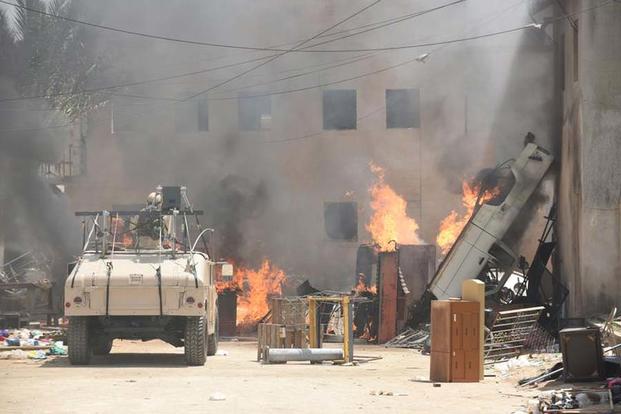FORT HOOD, Texas -- By night, the film set for "The Long Road Home" doubled as a tool for emotional healing.
Veterans of the fateful 2004 Iraq deployment portrayed in the miniseries would walk the painstakingly recreated streets of Sadr City, experiencing the location without the trauma and chaos they remembered so vividly.
Somehow, the familiar sights helped some find peace.
"It was like a freeze-frame of a memory that I could explore at my own pace," said Aaron Fowler, a veteran of the Sadr City fight who served as a technical consultant on the miniseries.
"So every opportunity that I could, I would get the veterans and I would give them a small little quiet tour," he said. "Because it's seriously like pausing the DVR and just walking through the memories. It's an amazing experience."
Related content: Tributes to 'Black Sunday' Vets at Premiere of 'The Long Road Home'
The National Geographic project follows elements of Fort Hood's 2nd Battalion, 5th Cavalry Regiment, through "Black Sunday," the harrowing fifth day of the deployment. Violence would erupt in the previously peaceful streets of Sadr City, and eight troops would be killed in what would be the start of 80 straight days of intense fighting.
Mikko Alanne, series showrunner and screenwriter, said the decision to film the series in its entirety at Fort Hood began with a desire to depict the families waiting at home with accuracy.
"As we say in our tagline, no soldier fights alone. That's what I wanted people to understand," he said. "We knew we wanted to recreate the experience as authentically as possible ... by filming in the actual homes, actual chapel, actual family readiness center."
And though filming meant logistical headaches for the base, such as closing down a major road for a full day to shoot a convoy scene, Alanne said Army officials accepted the challenge and made it happen.
"From the first moments, Fort Hood welcomed us with open arms. It's such a personal story for them," he said. "It was amazing to have their support, and in the same way the Army really embraced helping us in any way that they could. Never have I seen such care given to us."
In the miniseries, the military vehicles were mostly loaned from the Army, Alanne said. Soldiers from the base also feature as extras in many scenes.
As filming in the actual Sadr City was out of the question, producers started mulling the idea of re-creating the city at Fort Hood, using the same military operations in urban terrain site, or MOUT, that the soldiers had used for training ahead of their deployment.
For the project, the production crew would take over the base's Elijah MOUT site, building 80 buildings and re-facading another 35 structures over a sprawling 12 acres.
"We had the largest working set in North America," Alanne said.
To accurately recreate the Sadr City that the soldiers remembered, the crew leaned on photographs shot by troops and journalists and took oral histories from veterans of the fight.
"I remember when veterans would visit, they would just be struck silent," Alanne said.
Fowler marveled as the set rapidly took shape at the Elijah MOUT site.
"And at the beginning of production, I got to see it slowly get built up and, seriously, every night, there would be a new road built and probably 10, 15 buildings. Until it got to the point that the only thing missing from Sadr City was the smell," Fowler said. "When we brought vets and families on, they were very emotional."
Eric Bourquin, another 2-5 veteran who worked on the show as a consultant, said he also found the experience of working on-set to be healing.
"It was such a gift to actually be there, revisiting the battlefield, going into the house that they recreated from the pictures we gave them," he said. "Being able to sit up there on the roof with the guys that were on the roof with me and being able to relive it and talk about it. Who else can get that experience?"
-- Hope Hodge Seck can be reached at hope.seck@military.com. Follow her on Twitter at @HopeSeck.












